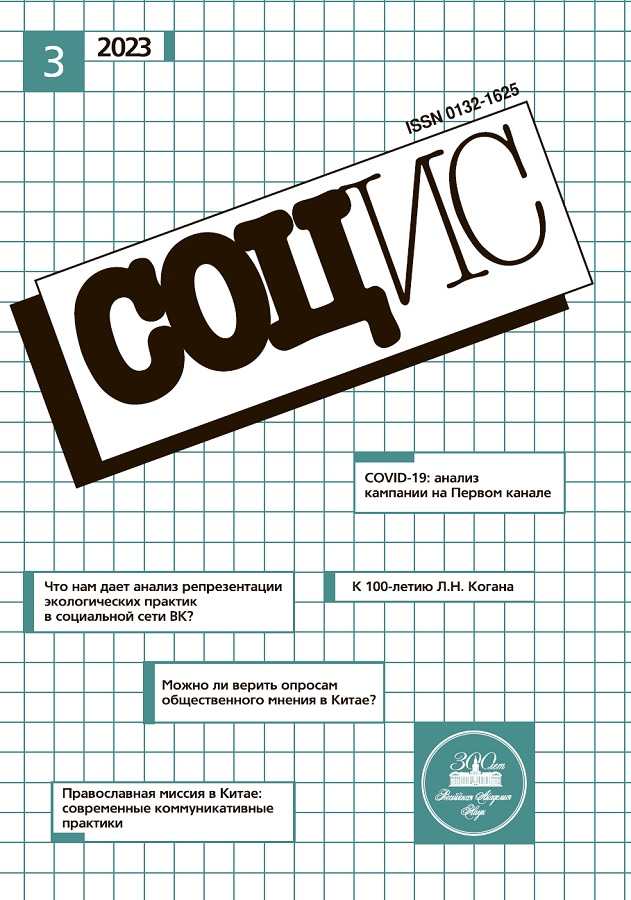Mediated Orthodoxy: Mission in China
- Authors: Ostrovskaya E.A.1, Badmatsyrenov T.B.2, Vasilieva S.V.2
-
Affiliations:
- Saint Petersburg State University
- Buryat State University
- Issue: No 3 (2023)
- Pages: 66-79
- Section: Articles
- URL: https://vietnamjournal.ru/0132-1625/article/view/661607
- DOI: https://doi.org/10.31857/S013216250022668-7
- ID: 661607
Cite item
Abstract
The rapidly unfolding processes of digitalization and mediatization are radically changing contours of social reality and semantic content of routine communication practices. Unprecedented arrangements of individuals, communications and media give rise to new meanings in translocal digital spaces of dialogue about different thematic sectors of reality. Religious websites, mobile applications, online lectures, sermons and divine services open up access to information and practices outside the boundaries of sacred territories and prescriptions expanding public discourse about religions, making available meanings previously hidden from external "non-church" or "uninitiated" search. In this article, we propose an examination of the current communicative practices of the Russian Orthodox Church mission in China. A respective sociological study may shed light on the interpretation of the mission by practicing priests serving in a foreign cultural environment, where Orthodoxy is a tiny island of sacredness for Russians as a "small nation" in several autonomous regions of the PRC and for those who came to it through individual spiritual search. This case makes it possible to get directly in touch with possible answers to questions about the very possibility of an Orthodox mission in societies of religious pluralism, but at the same time deeply secularized, commercialized and individualized. Secondly, for many decades the Orthodox mission in China has been the subject of research by orientalist and historians. Paradoxically, a detailed study of the past of the Orthodox mission in China does not enable scholars to elucidate its present, especially specifics of the connections between the structures of the Russian Orthodox Church, various actors and communicative media practices of Orthodox missionary work.
Keywords
Full Text
About the authors
Elena A. Ostrovskaya
Saint Petersburg State UniversityRussian Federation, St. Petersburg
Timur Batorovich Badmatsyrenov
Buryat State UniversityRussian Federation, Ulan-Ude
Svetlana V. Vasilieva
Buryat State UniversityRussian Federation, Ulan-Ude
References
- Афонина Л.А. Положение о религиозной деятельности 2018 года в КНР // Проблемы Дальнего Востока. 2018. № 5. С.138–154.
- Горбачев Б.Н., Манакова Т.Б. Возрождение святыни. Успенский храм на территории российского посольства в Пекине. М.: Вост. лит-ра, 2013.
- Дацышен В.Г. Христианство в Китае: история и современность. М.: НОФМО, 2007.
- Косых А.Н., диак. Православная миссия в КНР и восстановление церковной жизни // Вестник Омской православной духовной семинарии. 2017. № 3. С. 136–141.
- Косых А.Н., диак. Христианские церкви в Китае с 1978 по 2018 гг.: сравнительный анализ. Автореф…дис. канд. богосл. наук. М.: ОЦАД, 2019.
- Ли Иннань Миссионерская деятельность РПЦ в Китае – исторические уроки // Вестник культурологии. 2019. № 2. С. 194–207.
- Ломанов А.В. Адаптация и китаизация: современная религиозная политика руководства КПК // Международная аналитика. 2021. Т. 12. № 4. С. 88–105.
- Лукин А.В. Статус Китайской автономной православной церкви и перспективы православия в Китае // Аналитические доклады. 2013. Вып. 4 (39). С. ?
- Лян Чжэ. Православие в контексте современных российско-китайских отношений: взгляды китайских ученых // Вестник РУДН.Сер. Международные отношения. 2015. № 1. С. 79–87.
- Поздняев Д., прот. Православное сознание и китайский мир: от конфликта к диалогу. Владивосток: Приморский благовест, 2006.
- Couldry N., Hepp A. Mediated Construction of Reality. Cambridge: Polity Press, 2017.
- Hepp A. Deep Mediatization. New York: Routledge, 2020.
- Hepp A., Hasebrink U. Human interaction and communicative figurations. The transformation of mediatized cultures and societies // Mediatization of Communication/ Ed. by K. Lundby. Berlin/Boston: De Gruyter, 2014. P. 249–271.
- Hepp A., Hasebrink U. Researching Transforming Communications in Times of Deep Mediatization: A Figurational Approach // Communicative Figurations: Transforming Communications in Times of Deep Mediatization / Ed. by A. Hepp, A. Breiter, U. Hasebrink. Cham: Palgrave Macmillan, 2018. P. 23–24.
Supplementary files










